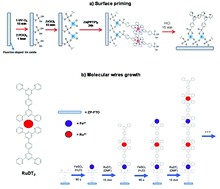A nano-junction of self-assembled mixed-metal-centre molecular wires on transparent conductive oxides†
Abstract
The fabrication of stable, highly conductive molecular nano-junctions is one of the main research goals in the field of molecular electronics. In this paper we report on the self-assembly and functional characterisation of highly conductive molecular wires, based on mixed-metal polynuclear complexes, at the surface of a transparent conductive oxide. The adopted synthetic approach involves metal-coordination reactions on oxide surfaces, pre-functionalised with a monolayer of terpyridine moieties that are used as anchoring sites for the integration of ditopic, redox-active ruthenium–bisterpyridine molecules through iron(II) centres. By the stepwise iteration of the iron-coordination reaction, molecular wires of the desired length can be prepared, which alternate iron and ruthenium centres in the wire backbone. The stepwise assembly of the wires at the transparent conductive oxide surface was characterised by means of UV-Vis spectroscopy and, at the nanoscale, by means of ToF-SIMS measurements. The electrical characteristics of the wires were obtained by the liquid-metal eutectic-gain nano-junction technique, with results that show good electron transport capabilities along the wires. The demonstrated feasibility of the integration of these metal-polypyridinic, redox-active, conductive wires at the surface of a transparent and conductive oxide, and the evidence for good electrical conduction indicates prospective applications in the field of nanoscale molecular optoelectronics.



 Please wait while we load your content...
Please wait while we load your content...